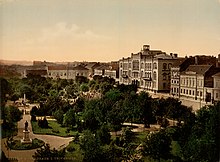University of Belgrade
| University of Belgrade Универзитет у Београду |
|
|---|---|

|
|
| founding | 1808 as a high school |
| Sponsorship | state |
| place | Belgrade |
| country |
|
| Rector | Ivanka Popović |
| Students | ~ 95,000 (2018) |
| Employee | 4,200 |
| Networks | AARC , BAUNAS |
| Website | www.bg.ac.rs |
The University of Belgrade ( Serbian Универзитет у Београду / Univerzitet u Beogradu) is the oldest and most important university in Serbia . With over 89,000 students and 4,200 academic employees, it is currently the largest university in Southeast Europe .
The university comprises 31 faculties and eight scientific research institutes. The faculties, or academic departments, are divided into five groups, depending on their academic characteristics: faculties of biotechnical sciences, social sciences , medicine , natural sciences and mathematics , and faculties of technical sciences.
history
founding

The forerunners of today's University of Belgrade go back to 1808, when the High School was founded by the Serbian enlightener Dositej Obradović in the course of the First Serbian Uprising . After the uprising was put down in 1813, it was initially closed again and only re-established in 1863 with the three faculties of technology, law and philosophy. On February 27, 1905, the high school was officially converted into a university.
First half of the 20th century
The University of Belgrade experienced massive growth and expansion in the years before the Second World War and especially after the establishment of the Second Yugoslavia .
Second half of the 20th century
In the 1960s and 1970s, the university developed into a notable regional and international educational institution. Many students from other countries were trained here. In socialist Yugoslavia , the university was further expanded, but at the same time was exposed to massive state and ideological influence.
Since the 1980s, the quality of university programs has declined due to political instability in the country. Due to the subsequent wars in Yugoslavia, there was an increasing lack of money from 1990 onwards, and the quality fell massively.
During the Milošević government in Serbia, the university faced external political pressures and a lack of academic and administrative autonomy. From around the mid-1990s, Belgrade University became a recognizable center of political opposition in Serbia. Massive anti-government protests were staged by the Belgrade students and professors. At the end of 1996 / beginning of 1997 plans were forged against the Milošević government, which in 1998 led to the establishment of the student protest movement Otpor , which made a major contribution to the overthrow of the government in 2000.
21st century
With the fall of Milošević on October 5, 2000, important steps were taken to improve the facilities and the quality of teaching. There have been numerous reforms in higher education in the country. Since then, the university has made great efforts to improve its internal structure. The quality rose again, but there is still an investment backlog.
Belgrade University Library
The university library is the only Carnegie library in Central and Eastern Europe.
Faculties
|
|
Personalities
A number of well-known personalities are associated with the university who have studied, researched or taught at it.
A list of these people can be found under List of Famous People of the University of Belgrade
See also
Web links
Individual evidence
- ^ University of Belgrade: University of Belgrade: History of the University. (No longer available online.) Archived from the original on January 9, 2011 ; Retrieved January 24, 2011 . Info: The archive link was inserted automatically and has not yet been checked. Please check the original and archive link according to the instructions and then remove this notice.
- ↑ http://bg.ac.rs/en/university/management.php
- ^ Members of AARC. In: www.alps-adriatic.net. Rector's Conference of the Universities of the Alpes Adriatic Region, accessed on September 14, 2019 .


